How to Identify a Worthy Niche in 2020
Trying to identify a niche to get into for your dropshipping business can be challenging. But there are steps you can take to validate a niche. In this video, successful dropshipper Marc walks us through how to research niches and products to focus on as well as identifying potential and saturated niches.
Jessica: Hey everyone, I’m Jessica.
Marc: And I’m Marc.
Jessica: And today we’re talking about how to research and validate niches. Marc knows a thing or two about validating this because he built a store that made $30,000 in six months.
Marc and I are going to walk you through how to research and validate high potential niches to dropship in by using specific tools like Facebook and Google and comparing three different dropshipping niches to determine what’s good and bad about each one. Stay tuned because this is a conversation you won’t want to miss.
We’re going to jump in and out of the laptop. That way you can follow along as Marc goes to different tools like Facebook and Google and shows you exactly how to use them to research and validate your niches. Occasionally we’ll zoom out because I have questions for Marc about why he’s using certain tools and why some niches are winners and others are not.
Alright, so today I’m here with Marc who started his own dropshipping business in early 2017 and made $30,000 in six months. And Marc just looking at you, you’re a stylish guy, I’m guessing you probably followed your passion and started a fashion store.



How Marc Found Success in Dropshipping
Marc: That was our first instinct with Noah. And our passion was the fashion niche like you just said. We started our fashion store after high school and started learning about the ways of ecommerce there.
Jessica: Okay. That was your first store. And is that the store that made you the $30,000 in six months?
→ Click Here to Launch Your Online Business with Shopify
Marc: Absolutely not. Honestly our first store, we made a few sales, but it wasn’t a huge success. We learned quite a few things, what to do and what not to do in business. And as soon as we started our second store, everything was straightforward. We had no big issues and we could manage to have a successful online store there.

Jessica: So then what was the difference between starting your first store based on your passion and starting your second store? What led you to the winning niche there?
Marc: Well, our instinct was to start a fashion store because of our passion. But we found that following your passion and building an online store according to that isn’t the most successful way to address things.
So with our second store, we trusted the numbers more than we trusted our own instinct. And that’s why I think it was so successful.
Jessica: All right. And so that’s what we’re here to talk about today is how exactly to use these tools that you used to do the research and find a winning niche.
Marc: That’s right.
Jessica: Okay. So the way today is going to work is we’ve got three potential niches and you’ve promised me you’re going to take me through how you would research these three niches, right?
Marc: Exactly.
Jessica: Okay. And what are those three niches?
Marc: So the first one is the camping niche. The second one is the cell phone accessories niche. And the third one is the teeth-whitening niche.
The Camping Niche Potential
Jessica: Okay. I’ve heard great things about all of those niches. I think camping sounds very steady. Teeth-whitening sounds trending. But this is all kind of going off what I’ve heard. So I’m excited to use these tools to really get down to the data. This is where a lot of new dropshippers would start just with some ideas. So what’s the first step now? You have these ideas. What next?
Marc: So one of the research methods is, of course, to have instantly an idea of a niche you maybe wanna research. Let’s say it’s the camping niche. The first step when researching a niche like that is to use tools like Google Trends or Facebook Audience Insights because these tools have a lot of data that you can validate in order to determine if the niche is worth trying or not.
Concerning the camping niche, whenever you’re in the Facebook Audience Insights tab, you see a lot of data. And first of all, you’ve gotta ask yourself, “What’s relevant to my idea of researching this niche?”
Consider the Location
The first and very important thing to consider is the location you’re researching.
So is it a niche that is only relevant to one country or is it a niche relevant to the whole world? Most niches will be relevant to the whole world. And that’s why most dropshippers test their ads worldwide just because it gives them more data to go with.

Jessica: That’s interesting. So even though a lot of dropshippers initially think about dropshipping to the US, you’re saying that in order to really find the winning product-market fit, you should start worldwide with your research?
Marc: That’s right. That’s what I’m telling you. And when first starting to research the camping niche in Facebook Audience Insights, you gotta ask yourself, “What is the camping niche composed of?” And what springs to mind is that it’s composed of many sub-niches. Those sub-niches can more easily be researched and it might be a hint that that’s a niche that can be exploited by many people without losing momentum in the market.
Jessica: And can you give me an example of one of these sub-niches that might exist within camping?
Marc: Within the camping niche, you have campers who are interested in hiking boots or sleeping bags or other tools required for camping.
Jessica: Okay. So Marc, what is the goal of this niche research? Is it to find a winning niche?
Marc: Well, the main goal of finding a niche is to find a niche with products to test from having quite some options, quite some choices you can make in the product testing process.
Jessica: Okay. So this is really about researching so that you know you’re doing smart testing when it comes to running ads for particular products and doing that research?
Marc: Exactly.
Jessica: Okay. And so with that in mind today as you share your insights, you’re really going to help people hone their instinct as they look at all these resources, what numbers are worth paying attention to and what aren’t.
Marc: Exactly.
Jessica: Okay, great. So say we’re going to research that and we have that first instinct, what’s the first website you log into to start researching?
Interest Targeting on Facebook Audience Insights
Marc: The first thing I do is go into Facebook Audience Insights and scroll down to the little search bar named interests.
There I can type in any keyword I want and basically Facebook is going to show me how many people are exactly active monthly in this particular niche.
Depending on the location you’re researching. So let’s take the outdoor niche and just type, out of common sense, “outdoor”.
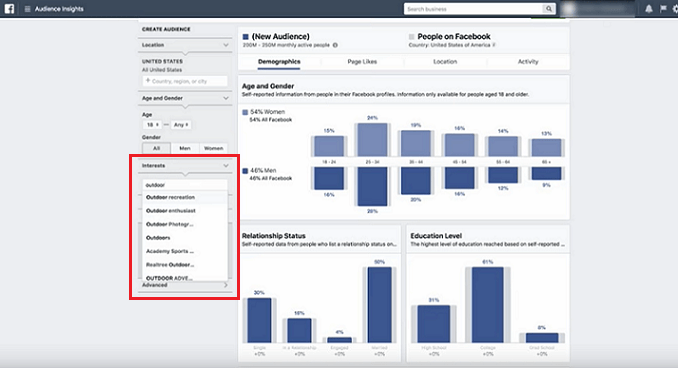
Jessica: Okay.
Marc: So the Audience Insights suggest to us several options we can choose from. So, “outdoor recreation”, “outdoor enthusiast”, “outdoor photographer”. So, we see immediately that the outdoor niche we are facing, for example, the camping one, doesn’t have a lot to do with outdoor photography. It’s kind of a different one, so we can eliminate that. But what seems relevant is outdoor enthusiasts, because it’s the people basically wanting to do camping. So, out of common sense, I’m just gonna search for that.
Jessica: Now I can see after you entered “outdoor enthusiast” as an interest here, Facebook is telling us that there are 4 to 4.5 million monthly active people. And just to back up, the reason that we’re using Facebook Insights in the first place is that Facebook is a really popular way to advertise products once you’ve chosen them, right?
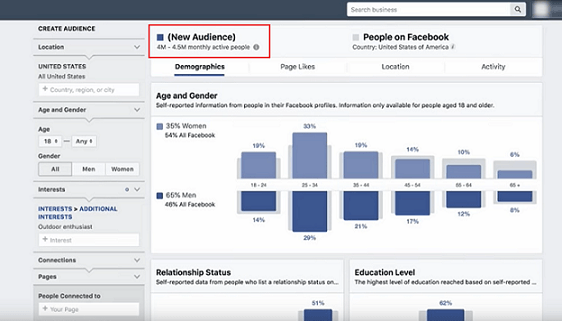
Marc: That’s right. So once you have an idea of the product which might be successful, researching it on Facebook is always the best idea, because Facebook gives you straight up data, that you can validate for this particular niche or for your idea and determine immediately within five to ten minutes if this idea, if this instinct you got is the right one.
Jessica: So, now we see a lot of numbers after you entered just that one term, we see that they’re 4 to 4.5 million people interested in this, and I see all kinds of percentages. And as a new dropshipper, I think I might just want to quit ’cause I’ve never seen so many numbers on the screen in my life. How do you make sense of all of this?
Marc: So that’s understandable that someone new to dropshipping would feel absolutely overwhelmed by those numbers shown by the Audience Insights. But you can relax because most of the numbers are only relevant as a general idea. Very few numbers here are very relevant to whether you should try this niche or not.
So, the first thing… In the first tab here, you have the demographics. That’s the most irrelevant tab when it comes to, “Should I go into this niche or I should not,” right? You have the percentage of women, the percentage of men, the age groups, then you have relationship status, education level, and the different job titles and sectors these people work in.
This is normally not something you would target in the Facebook ad in the end because the Facebook algorithm is smart enough to figure out if a man or a woman will buy this particular product.
Jessica: So, you don’t need to do that work, Facebook will do it for you.
Marc: As you can see, we typed in “outdoor enthusiast” and Facebook immediately knows that 65 percent are men and 35 percent are women. That means the algorithm was smart enough to give us that information, which means it will be smart enough to kind of split your budget 65 to 35 if it was only the variable of men and women in this whole scenario.
Jessica: So you said now, looking at the demographics tab well, it’s interesting when you’re in this stage of dropshipping, the niche validation, niche research stage, this tab of demographics actually isn’t that important. So, then, what is important on this page? Which tab would you go to first?
No Such Thing as Ideal Audience Size
Marc: So, after having a quick look at this page, just to get a general idea of how many people are actually in that and what age groups are in there, you can go to “Page Likes”. This is the most relevant tab in the Facebook Audience Insights because it gives you ideas of what exactly you should target whenever you wanna get into this niche.
So, let’s say you’re past the point of the audience being big enough for you. You say, it’s worth trying out of demographics because that’s really the only thing that matters if the audience is big enough.
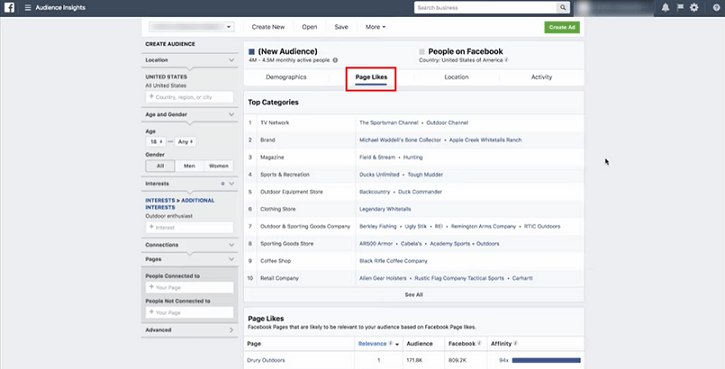
Jessica: Well then, I’m going to interrupt you because is 4 million a big enough audience?
Marc: There’s no such number as to say if an audience is really big enough or not because it purely depends on whether it is a general niche or a sub-niche? Because for a sub-niche, it sure is a very big sub-niche. For a niche in general, it’s very small. But we gotta remember, we’re in the United States right now. So, it’s very trimmed to US interests, right now.
In a second, I will switch it to worldwide, so we can see the different insights into this particular niche. And we’re not even in the whole niche, we’re in the outdoor enthusiast keyword search, so it’s not even the whole niche.
If there are 4 million outdoor enthusiasts, then we can suspect that the whole niche is much larger than this.
So, as I said before, the “Page Likes” tab is the most relevant in the whole Facebook Audience Insights because a lot of people struggle with targeting inside their Facebook ads when creating the Facebook ad.
So, looking at this TV network brand magazine, that’s the type of categories people are liking. And on the right side, we see the exact names of relevant names people are researching who are interested as outdoor enthusiasts. So, just to clarify, when researching the outer enthusiast niche, we don’t only get pages related to outdoor and camping.

Jessica: Yeah, I’m looking at this list now, and I see that there is a coffee company at number nine. It’s like one of these things just doesn’t belong. So is that a piece of data that we should throw away ’cause it doesn’t have anything to do with outdoor enthusiasts?
Marc: It’s definitely relevant because even though it doesn’t have anything to do with outdoor enthusiasts, in some kind of way, it does because it gives that the general behavior of outdoor enthusiasts, which means when we target somebody interested in the Black Rifle Coffee Company, we might even target somebody within this audience as an outdoor enthusiast.
So, it’s kind of an alternative way to reach the people you are looking for in the end. All other things we see here or almost all of them are outdoor-related in a direct way. So, it’s common sense to target that within your Facebook targeting when you see that.
Jessica: So, when you’re researching a niche, are you looking for these opportunities to reach an audience in indirect ways? In other words, you’re researching outdoor enthusiasts, and you see this opportunity to target people using a coffee interest, does that make this niche more attractive to you?
Marc: It tells me that the niche has different possibilities to get reached. So many niches don’t have this kind of option. And that means you’re limited to your options targeting this particular niche. Because in the beginning, you are targeting different ad sets with different interests and when you’re limited to your choices, let’s say, you can only target outdoor specific brands or TV networks. At some point, you’re gonna run out of juice because you don’t have any more ads to publish out of that. I’m talking about call traffic ads here.
In this example here, we can see that the outdoor enthusiast keyword triggers a lot of pages or page likes with different audience sizes which seem very relevant to our targeting. This tells us that this might be a very good niche to target or to research within specific products.
Now if we switch the location from the United States, which is already a four million audience, to worldwide, we just get rid of the United States up here. It tells us the number of people who are on Facebook in general, inside this niche, and that’s nine to 10 million. That’s not the biggest niche, but that’s definitely a good one to target because we’re talking about monthly active users here. And like I said, this is a keyword, not the whole niche.
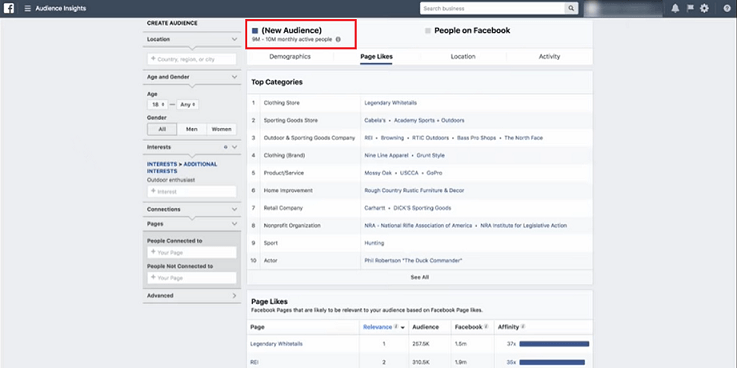
So as we also see the interest kind of switch here to US trimmed ones, from US trimmed ones to worldwide ones. So when we start our ads, we won’t start by US targeting as we mentioned before, but we will start with worldwide targeting, which means we have a lot more to test here.
If we target a worldwide ad and we use one of the US-specific targeting options, the algorithm is going to know that most people interested in this are in the US, so even though we are on worldwide most of our budget will go to the US. And that’s a very cheap option to target the US for example, if we wanted to.
Jessica: I see, so, so far what you’re liking about this niche is the fact that it’s A, it’s a big niche, B, there is a, let’s say, non-intuitive interest within our niche that we can use to target people who might buy outdoor gear without actually paying to target the outdoor audience and that’s the coffee company.
And then C, you like this niche because once we got rid of the worldwide location, coffee disappeared, which means if we were to create an ad without targeting the US, we could use the coffee interest to secretly target the US for less money.
Now, one thing I wanna ask you about, another Facebook Ads pro told me that this affinity score was really important when I was researching my niche. Is it?
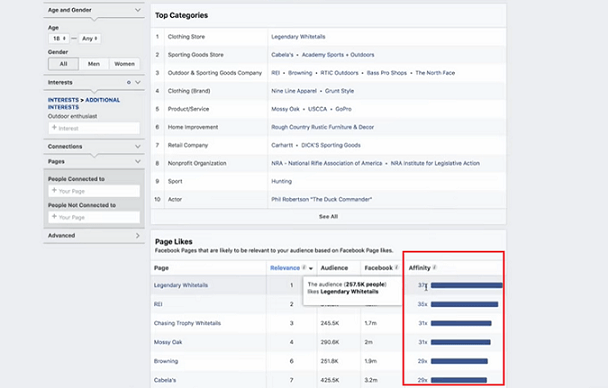
Marc: I agree it is important, but I don’t think it is the most crucial thing to consider. Now, a big affinity score is a very good indicator that this is something worth trying even more, but it’s just a supportive argument if you want to say it like that, it’s not a determining factor.
Jessica: Okay.
Marc: And one more thing I’d like to point out, coming back to the coffee interest, you can target worldwide with coffee, but don’t think you are targeting most of the people in the outdoor niche through this coffee interest because most of the people will have the coffee interest, not the outdoor interest.
So you would have to narrow this audience even further by including some other interest in outdoor niche, so it might be outdoor enthusiast, but it might also be something different as a keyword in the outdoor niche because we gotta be more specific with that.
Jessica: Okay, so on a scale of one to ten, one being you’re totally over this niche and ten being you’re all in, what do you feel about the outdoor enthusiast niche right now?
Marc: Honestly, I gotta say I would do further research for that particular niche. I would not agree yet to go and test something in this niche. But as soon as I’ve researched a certain sub-category of this particular niche, I might just be inclined to.
Jessica: Okay, so maybe you’re a six right now.
Marc: Yeah, maybe a six.
Jessica: Okay, so what’s the next step?
Target a Specific Product in a Niche
Marc: Alright, so now that we’ve determined that we’re going to do further research, we’re going to target a specific product in this niche. So I’ll ask you to pick a random one out of the outdoor niche.
Jessica: Sleeping bags.
Marc: Alright, great, so we will search for sleeping bags here in the “interests” tab and we see on the right side that through the page likes, we have a very popular company here, The North Face, selling sleeping bags. They also sell other stuff, but it’s the top two in the categories that Facebook is suggesting.
So that means that a lot of people are interested when searching for sleeping bags, buying from The North Face. So generally a good idea would be to go on the page of The North Face and just to see what exactly they are selling as bags.
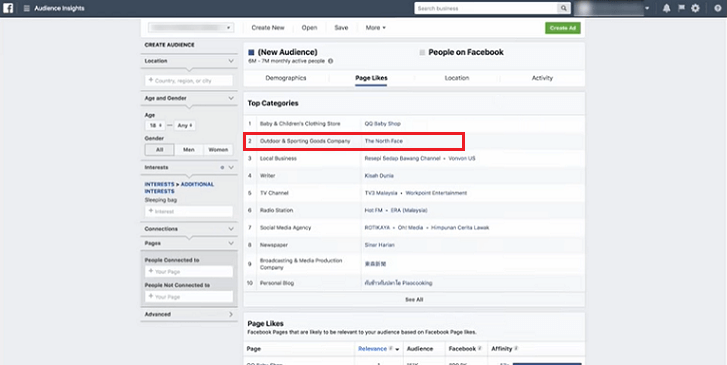
Marc: Alright, to not get too confusing, maybe I’ll straight up go to the sleeping bags category here and see what kind of sleeping bags are sold on The North Face. So I’m gonna filter that not by relevance but by best-sellers to instantly see what’s popular in this company.
Now, this may be a pretty dull example because as we see, even the best sellers kind has similarities. It’s just a different color and it’s not telling us very much what this whole thing is about, what the best seller of this niche is all about.
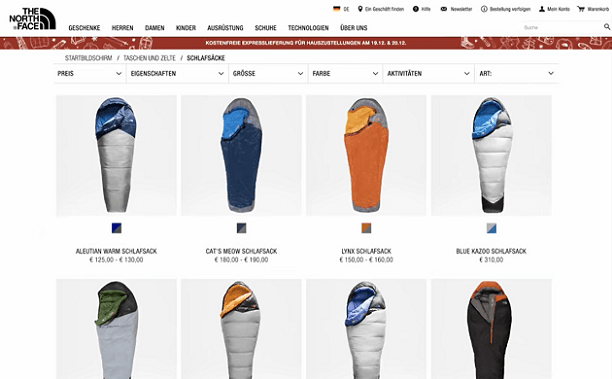
But the thing we can tell is the best seller here is cheaper than all the other ones, which means for this particular niche, people are looking for quality because The North Face is a company which values quality but also the price range.
So, of course, it brings to mind that the price is always something very important within a niche. People care about the price. But in some niches, it is true that the price truly doesn’t matter.
For example, across niches where a lot of experts and business people who buy equipment for their business. There the quality is more important than the price.
So that’s something you gotta keep in mind.
But in this example, we see that the most popular bag is cheaper than the other ones. And we’re not going to interpret why people are buying this cheap bag. We’re just going to say maybe they wanna go on vacation and they need cheaper options, they don’t wanna spend €300 on the top model but maybe just €130, that’s alright for us, okay.
So now that we have a general understanding of what the top seller sleeping bag looks like, we might search for other products because we’re not gonna stick to a single product here. But we want again, a certain understanding of all the products in the niche in order to figure out what exactly we’re going to pick among those products in order to test them.
So the next product we’re going to research won’t be through Facebook Audience Insights because, you can, of course, do that, but I’m here to show different variants in order to determine which product you’d like to research because normally when I research those things, I’m searching all the products here or on Google Trends and I’m having a kind of a comparison here.
Jessica: I see, okay.
Marc: But to be more straightforward here, we’re going to Google Trends immediately and search for the product we just researched on Facebook Audience Insights, which is sleeping bags. Right, okay. We’re going to search for sleeping bags here.
Okay, so we see a pretty high relevance score in the United States, but as we searched in the worldwide tab we’re going to target worldwide in Google Trends too. So the worldwide one is similar to the United States but a little bit more constant, okay. And here we see the countries researching mostly sleeping bags: New Zealand, Australia, and the United Kingdom are the top three countries interested in the sleeping bags.
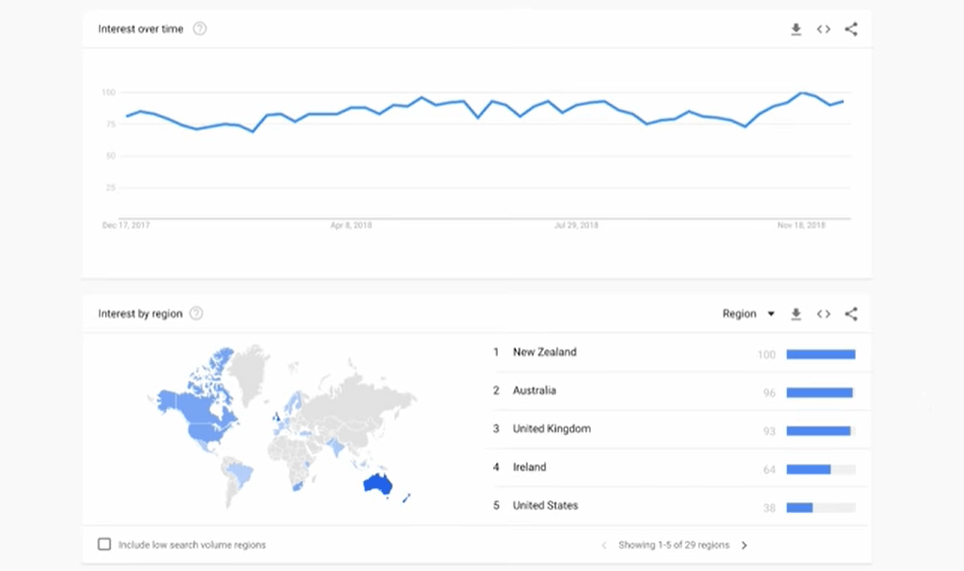
Jessica: I’m surprised to see Ireland ahead of the United States.
Marc: Well, some things can’t be explained, but as you see, this is the data we get. So this is basically a perfect example that your instinct or your idea of this product or where it might be popular isn’t right, because you see that Google Trends is showing you something different here.
Now the time frame which we are going to analyze it in can be the past 12 months.
It’s kind of a good idea for a niche, which is always trendy to research it in the past 12 months because we know that over five years, it’s going to perform well.
But we wanna know if right now it’s a good time to get into it.
So the camping niche, in general, is a niche which is relevant mostly to warmer weather because people will not go camping in the winter, obviously. But here’s the point I’m trying to make. People go camping in the summer. But most discounts are in the seasons where it’s not obvious that people are going to buy them and people know that, which means a jacket is relevant in winter and not in summer, but people are buying it in summer because the most discounts are issued there.
Jessica: Is that why we see that demand seems to peak in the winter when people probably aren’t camping?
Marc: Exactly. That might be one explanation but there might be many factors coming to this, so I wouldn’t lock myself into confirming that 100 percent. Another thing we gotta consider is that Google Trends gives us relative numbers from zero to 100.
Okay, so it’s always good to have a comparison item. So one item is sleeping bags but maybe you can tell me what else you would like to research inside this niche as a product so we have a comparison within Google Trends.
Jessica: Camping tents.
Marc: Camping tents, okay. So we’re going to search for tents and see immediately that more people are looking for tents than they are for sleeping bags.
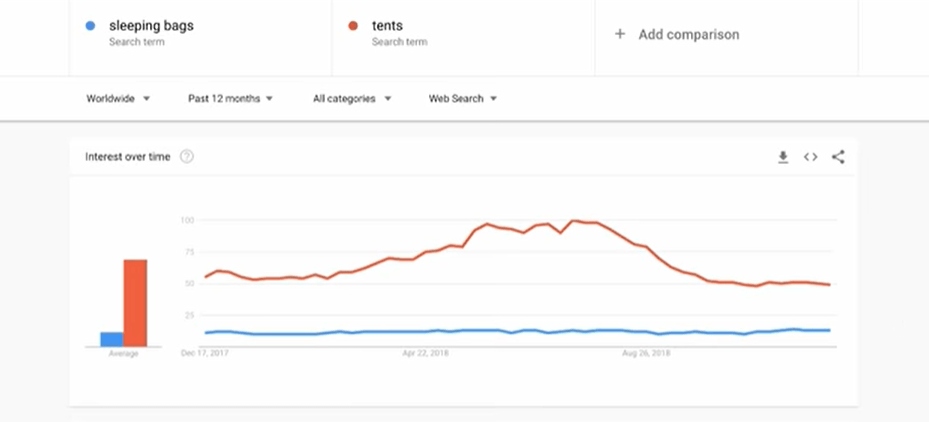
Jessica: Interesting.
Marc: Which means the relative numbers we got high in the 70s for the sleeping bags are nothing compared to the tents research. And you see that it’s more inconsistent as a product, tents. So that’s something very, very important to consider. And beginners might get stuck with this because they see, “Okay, the demand is high. I’m going in right now.”
But before doing that, you have to always ask yourself, are those relative or absolute numbers, and in this case, it’s relative so we gotta compare it to something else, in this case, tents.
Jessica: So now I see this chart, and I think, “Alright, research is done. Let’s sell tents.”
Product Research on Popular Ecommerce Stores
Marc: You could say so, I guess because we have a comparison within the niche already. Now, if you wanna be a little bit more thorough than that, I would suggest you research a couple of more products and compare them in the same way within Facebook Audience Insights and Google Trends.
But… As we’re not finished here, I would suggest going on the top-selling ecommerce stores which are, mostly, Amazon or eBay… Most popular ecommerce stores and researching the top tents, the top sleeping bags, whatever is performing well according to this data.
And seeing what kind of model trends there, because we saw on The North Face that this €130 sleeping bag is quite popular. But, is it generally the case with sleeping bags? Do we have other companies coming into play and maybe there’s another product coming into the market, because dropshipping products, in general, aren’t known for innovation, but for the volume they’re selling and for their popularity in general.
But these products generally already exist from other companies trading them. So, the sleeping bags we saw on The North Face is a popular choice which we might even find in another dropshipping marketplace wherever our product is from and whatever we are selling.
What we are going to do now is type in the popular choice we saw on Google Trends and search for it on Amazon, a very popular ecommerce platform as everybody knows. And here, we can see the most popular choices for tents, the price ranges and most importantly, customer’s reactions to this product.
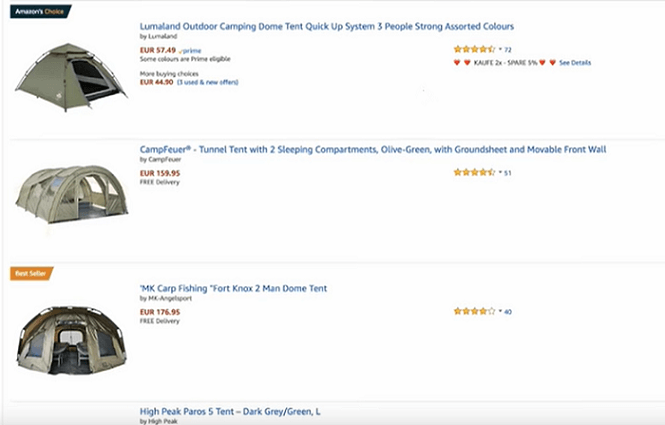
So, if we find in some other dropshipping marketplace a similar product to this top tent here, we might have great success because the quality will be comparable to this and obviously, people like it. The price we will have to undercut it because this merchant on Amazon already has established a market for this on Amazon. We as an outside store, not using Amazon have to figure out how we’re going to establish our own customer base for tents.
So, choosing a similar tent may be smart but we have to undercut the price here, just by a little bit so that people have a basic reason to buy from us. We will provide them later on with further reasons why they should buy from us. But for now, that’s all we’re going to worry about.
Jessica: Okay, so we’ve been scrolling through tents and it’s obvious just looking here that tents are a saturated product. They’re all over Amazon. But we know because we were researching other things like sleeping bags, that outdoor equipment is not a saturated niche. In this case, the product is saturated, but not the niche.
So now what I’m wondering is, what does a saturated niche look like? What’s a good example of that?
How to Identify a Saturated Niche
Marc: So, you got a point that’s true with the auto niche, and a good example of a whole saturated niche… Is a niche-related to one single product taken over by a certain brand or a group of brands? So, that’s a good indicator for a saturated niche that you shouldn’t go into, that is maybe a red flag for it.
So, a niche like that, it’s the teeth-whitening niche. There are some brands known to dominate that niche and dropshippers are not getting into certain products there on purpose because they already know out of basic research on Google, that certain companies have too much influence in a certain niche.
So, even though this is the case if we go on the research of particular products in the teeth-whitening niche, we see that the products listed here are kind of repetitive. So, we see the charcoal powder here, it’s kind of a bamboo powder whitening your teeth. And, that’s a very popular product among dropshippers.
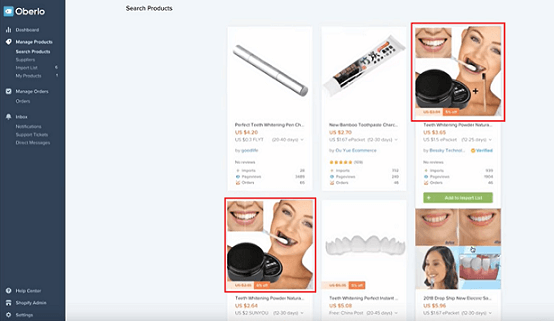
Jessica: You’re right, because… So when I think back to when we were thinking about camping equipment, camping equipment or outdoor equipment can be anything from boots to tents to sleeping bags and lots more besides that. But here, we search teeth-whitening and we’re really getting the same three products over and over again.
Marc: You can see that the niche has other options here you could test.
But generally, you need to keep in mind that a product which is going to repeat itself within the niche such as the powder is an indicator that the niche does need other products to compete with it because people have already made up their minds.
They want this product and they’re not going to buy other products, which are not established yet because this seems to work, people are conservative in this regard.
How to Identify Worthy Niches to Get Into
Jessica: Okay. And you were noting that there aren’t very many products within this niche. And it seems like people kind of go back to the same couple of things, the tooth-whitening powder and the gel.
So that makes it difficult for someone to find a product in this niche that hasn’t already been found by other dropshippers. Now I’m wondering what’s a niche that has a variety of products and is always adding more and more.
Marc: A good example of such a niche would be the phone accessories niche because phones have all sorts of accessories complementing their basic functionality and expanding it, basically. And, because you have so many different products and so many new phones and smartphones coming out, there are always new models for the market to test.
This means for you that you have to… Kind of look at your options in the market and see maybe oh, a new phone comes out. Well, let me test a new camera lens for this particular phone. This might be a winning product in the end. So this is basically a good example of a niche where you could have a saturated market, but still, open up for new possibilities.
Jessica: I see. A lot of dropshippers or new dropshippers even would recognize, “Wait, phone accessories? We hear everyone is selling phone accessories.” But what you’re saying is because phones are always changing, the product selection is always changing…
Marc: For example, yeah.
Jessica: So while the niche seems saturated, a product could still be unsaturated and ripe for the dropshipping.
Marc: Exactly.
Jessica: I see.

Because if the case is that you only wanna sell high-ticket products, a niche like the phone accessories niche isn’t gonna be right for you because phone accessories are almost always cheap. You get the point.
Put Yourself in the Shoes of Your Customers
Jessica: Yeah, okay so we’ve covered a lot, we’ve talked about how to use Facebook Insights and Google Trends to research products, how to check if those products are saturated with Amazon and Google search even and then we’ve also talked about whether niches are saturated or whether products are saturated and how that difference can really signal a lot of opportunity for dropshippers.
Do you have any closing thoughts, any dropshipping mistakes you see dropshippers doing a lot that maybe they should try to avoid doing if they’re starting out?
Marc: When you’re starting out as a dropshipper, you normally don’t have the necessary instinct to see immediately if a product is good or bad. You need to look at a lot of data, research a lot of things in order to determine if this something I wanna spend money on.
But something really everybody can do is listen to one’s own instincts as a buyer.
So put yourself in the shoes of your customer, and think, “What would I wanna see as a customer and immediately feel tempted to buy?”

Because if you feel tempted to buy, there’s a good chance other people will feel tempted too. So that’s kind of a determining point if a product is something you didn’t think you needed, but you see the ad and then you think, “Oh, this is actually a great product, I might just be inclined to test that.”
So that’s kind of a determining factor if this is a good product or not, regardless of what you saw on the Internet. Of course, you shouldn’t go against the data of saturated niches and just rely on that, but that’s kind of a very helpful instinct I think.
Jessica: So it sounds like dropshippers really should balance the two, do the research, but then also do a gut check and think, “Would I buy this, would a customer who is in this market buy it.?”
Marc: And the good news is, the more you combine and balance these two and the more you test, you basically develop your instincts with it. So they kind of merge into one because you’ve already seen what works, data-wise, and what works instinct-wise, and over time, the two things get on a very similar level.
Jessica: Well Marc, thanks so much for joining us today, you’ve shared some incredible insight.
Marc: Thanks for having me.
Jessica: And here’s Marc and his business partner Noah’s success story. Also, if you’ve got questions for Marc he’ll gladly address them in the comments section so make sure to leave them below, too. Thanks so much and until next time, learn often, market better.
Marc: And sell more.



